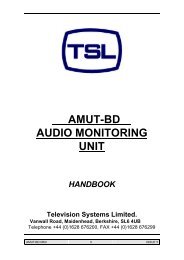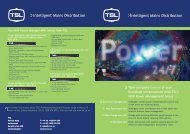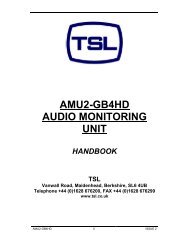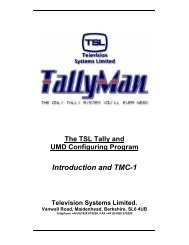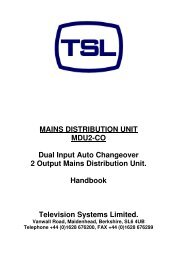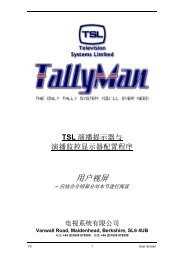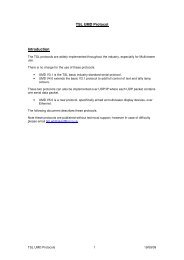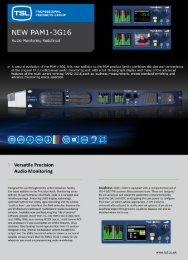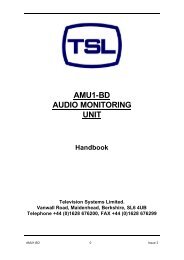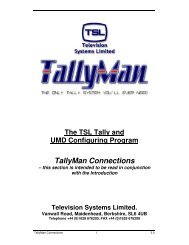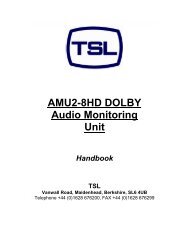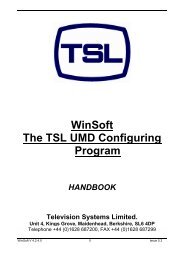Case Study: Sky News Arabia - TSL
Case Study: Sky News Arabia - TSL
Case Study: Sky News Arabia - TSL
You also want an ePaper? Increase the reach of your titles
YUMPU automatically turns print PDFs into web optimized ePapers that Google loves.
<strong>Case</strong> <strong>Study</strong>: <strong>Sky</strong> <strong>News</strong> <strong>Arabia</strong><br />
Fully file-based <strong>News</strong> Operations Centre
<strong>Sky</strong> <strong>News</strong> <strong>Arabia</strong><br />
<strong>TSL</strong> builds the largest and most advanced <strong>News</strong> Centre<br />
in the Middle East for <strong>Sky</strong> <strong>News</strong> <strong>Arabia</strong><br />
From Design to Reality…<br />
<strong>Sky</strong> <strong>News</strong> <strong>Arabia</strong> is a new venture, which will bring world class news coverage to the<br />
Middle East, in the Arabic language, 24/7. It will be transmitted in both SD and HD,<br />
and its news coverage will also be available online, on tablets and on smartphones.<br />
As a start-up, its production facilities represent the state of the art in television and online<br />
news, and building its new centre was one of the largest undertaken in the region.<br />
The broadcaster is a joint venture between B<strong>Sky</strong>B, the company<br />
owning the UK’s <strong>Sky</strong> brand, and Abu Dhabi Media Investment<br />
Corporation. Its production facilities are housed in a completely<br />
modernised studio on the twofour54 campus, and a new three storey<br />
block has been built alongside it to house the newsroom, graphics<br />
and editing, and machine rooms and operations centre. The business<br />
requirement was to concentrate on the quality and the scope of<br />
the newsgathering, so workflows in the new facility had to be as<br />
automated and streamlined as possible.<br />
For a very large scale project the timescale was tightly defined, with<br />
the broadcaster planning to award the systems integration contract in<br />
the early part of 2011. System design, construction, installation, and<br />
training and rehearsals – for a largely new staff drawn from the Middle<br />
East & North Africa region – had to be completed for an on-air date in<br />
the spring of 2012.<br />
Following detailed negotiations, <strong>Sky</strong> <strong>News</strong> <strong>Arabia</strong> awarded the<br />
contract to <strong>TSL</strong>. As a major international systems integrator, <strong>TSL</strong><br />
could demonstrate success in large-scale projects, and the ability to<br />
drive leading manufacturers to achieve new levels of integration and<br />
interoperability. It had an existing base in the United Arab Emirates<br />
which would provide local support and staffing. <strong>TSL</strong> also had facilities<br />
in the UK large enough for the complete system to be built and tested<br />
while the site was being prepared.<br />
Most importantly, it brought a completely vendor-agnostic approach<br />
to system design, which allowed <strong>Sky</strong> <strong>News</strong> <strong>Arabia</strong> to specify some<br />
key pieces of equipment, and to develop a pragmatic approach to<br />
the rest of the architecture, which was important to deliver a system<br />
which was not only functional but easy to support over the lifecycle<br />
of its capital investment.
Studio and control:<br />
A seamless flow<br />
<strong>Sky</strong> <strong>News</strong> <strong>Arabia</strong> elected to create most of its<br />
24 hour output from a single large studio, with<br />
a number of presentation areas within the sets<br />
dedicated to different programmes and parts<br />
of the day. To provide a seamless flow from<br />
one area to another, and to give directors<br />
maximum flexibility, 11 cameras are provided.<br />
Motion graphics, clips and crafted packages are<br />
triggered by the Grass Valley Kayenne.<br />
Sony HD cameras, Vinten Radamec robotic<br />
pedestals, Grass Valley Kayenne production<br />
switchers and Calrec audio mixers were used,<br />
with motion graphics and clips triggered<br />
by the Kayenne switcher from Grass Valley<br />
K2 production servers and the large Vizrt<br />
graphics system. All production content,<br />
including crafted packages are held on the<br />
EVS storage area network, and they too are<br />
cued from the Kayenne.<br />
One of the most distinctive features of the<br />
project is the use of an overall monitoring<br />
and routing layer driving very large monitor<br />
walls: they are amongst the largest ever<br />
built. Routing and processing is by Miranda.<br />
As well as the studio control room, the<br />
large monitor walls provide viewing of all<br />
sources or multi-view layouts in the network<br />
operation centre.<br />
An Avid i<strong>News</strong> system provides the editorial<br />
facilities. This is linked, through MOS, to Vizrt<br />
graphics and a large EVS media production<br />
server system, which provides the asset<br />
management for all production content.<br />
As well as controlling recorded material<br />
inserted into the news programming, Harris<br />
provides automated playout, switching<br />
between the studio and recorded content<br />
and commercials. Omneon servers are used<br />
for transmission, and there are two TX suites.<br />
The SD and HD versions of the channel run<br />
basically the same programmes, but graphics<br />
and interstitials are tuned to each variant so<br />
the two are treated as separate outputs.<br />
There is a Spectralogic tape robot linked to<br />
the EVS and Omneon server networks. Front<br />
Porch Digital archive software talks to the<br />
EVS and Harris software to ensure efficient<br />
retrieval of content.<br />
The project also includes the construction of<br />
a small contribution studio.<br />
Instant access to assets<br />
A vast amount of content is planned to arrive<br />
at the station each day, from local crews and<br />
from feeds around the world. Ingest is on to<br />
the EVS server network, from where it can<br />
be accessed by any user.<br />
Highly integrated audio and communications using Calrec, Riedel and advanced telco management from PhoneBOX.<br />
Content can be accessed by any user from the EVS server.<br />
12 edit suites are included in the project,<br />
running Apple’s Final Cut Pro. These are<br />
editing directly on the EVS storage area<br />
network for maximum speed and efficiency.<br />
Completed packages are dropped into a<br />
dedicated folder for checking, quality control<br />
and delivery to playout.<br />
All graphics systems are provided by Vizrt.<br />
Extensive use is made of template graphics,<br />
allowing journalists to complete captions from<br />
their desktops. More sophisticated graphics<br />
and maps are created by specialists and<br />
transferred to the studio for transmission.<br />
Unique: Fully integrated crossvendor<br />
bookings solution<br />
A project of this scale, which looks to<br />
achieve efficiency through automation,<br />
calls for the integration of systems from<br />
a number of manufacturers, which in<br />
turn requires new developments in those<br />
products and to create an open interface<br />
between them. Designing these interfaces<br />
and promoting the development of the<br />
additional functionality is a critical aspect<br />
of the system integrator’s task.<br />
An excellent example is in the unified bookings<br />
system required by <strong>Sky</strong> <strong>News</strong> <strong>Arabia</strong> for its<br />
communications systems around the world. In<br />
the traditional television news operation, each<br />
element required is booked separately, calling<br />
for a lot of manual co-ordination. <strong>Sky</strong> <strong>News</strong><br />
<strong>Arabia</strong> wanted to be able to make a single<br />
booking for all functionality.<br />
The solution uses the ScheduAll booking<br />
system, to which the manufacturer developed<br />
additional functionality to provide connectivity<br />
with a number of other systems. These<br />
include Miranda routing, quality control and<br />
editing, as well as IP circuits and switches<br />
and recording. An extension to the contract
will add control of the satellite farm, so dishes<br />
and transponders, together with Tandberg<br />
& Harris encoders and decoders, will be<br />
included in the unified booking system.<br />
<strong>TSL</strong> drove the development of new functionality<br />
for the Broadcast Bionics PhoneBox system.<br />
It is now capable of controlling the Riedel<br />
intercom infrastructure, so that as well as<br />
setting up the complete signal path a ScheduAll<br />
booking also sets up the talkback paths<br />
between the appropriate locations.<br />
The result is that a single booking can set<br />
up an encoder in, say, Cairo, and connect<br />
it via MPLS or satellite path to <strong>Sky</strong> <strong>News</strong><br />
<strong>Arabia</strong>; route it to a decoder, frame rate<br />
convertor or audio shuffler as required;<br />
record it to the server and update the asset<br />
management; and ensure that all participants<br />
are connected on talkback. All the elements<br />
are automated, so the booking merely<br />
requires source, destination file and time.<br />
Viewer loyalty across<br />
all platforms<br />
All content within the centre is file-based,<br />
and because the station is new there is no<br />
historical backlog of video or audio tape. This<br />
means that all content transfers are over IP.<br />
To accomplish this while achieving broadcast<br />
standards of reliability, and allowing priorities<br />
to be set for traffic close to air time, calls for<br />
careful design of the IP infrastructure. This<br />
is a very significant challenge for the system<br />
designers. While many system integrators still<br />
lack a real understanding of what is required<br />
in this area, <strong>TSL</strong> has invested significantly in<br />
skills and staff in recent years, recognising<br />
that it is the difference between success<br />
and failure in a tapeless environment.<br />
A Spectralogic tape robot ensures efficient<br />
retrieval of content.<br />
To deliver the required capacity and<br />
latency performance <strong>TSL</strong> specified multiple<br />
networks, with Cisco Nexus 7000 switches<br />
in a collapsed core topology. This allows the<br />
content network to be managed and for all<br />
performance indicators to be achieved.<br />
Built in to the requirements from the start<br />
was the recognition that television news<br />
now relies on non-broadcast content, and<br />
has to deliver to non-broadcast platforms.<br />
It was a central requirement that <strong>Sky</strong>pe<br />
video conversations should be used live<br />
on air, for example, or that YouTube or<br />
other User Generated Content (UGC) videos<br />
should be capable of being broadcast as<br />
soon as they were on line. Given that the<br />
design for <strong>Sky</strong> <strong>News</strong> <strong>Arabia</strong> was being<br />
developed at the time of the revolution<br />
in Egypt, these requirements were very<br />
much in the forefront.<br />
Equally, audience loyalty is retained when<br />
they can access news from their preferred<br />
trusted source wherever they are. Making<br />
the same content available in multiple<br />
formats online for a range of IP devices<br />
from smartphones to the web called for a<br />
fast transcoding farm and the broadcaster’s<br />
own content delivery network to push the<br />
material out.<br />
These new requirements added to the<br />
traditional broadcast requirements of lines<br />
from remote bureaux, ingest, feeds to uplinks<br />
and other broadcast hosts. The result is that<br />
<strong>Sky</strong> <strong>News</strong> <strong>Arabia</strong>’s network operations centre<br />
is large, featuring numerous operational<br />
positions sharing a huge monitor wall:<br />
10 metres wide and with 400 tiles.<br />
Simplified support with<br />
vendor synergy<br />
The philosophy of <strong>Sky</strong> <strong>News</strong> <strong>Arabia</strong> at the<br />
start of the project was to make a significant<br />
capital investment to achieve a system which<br />
worked smoothly and reliably, and used<br />
automation to minimise the requirement<br />
for operational staff. <strong>News</strong>gathering is<br />
expensive, and <strong>Sky</strong> <strong>News</strong> <strong>Arabia</strong> wanted<br />
to devote as much of its operational budget<br />
on getting journalists and crews out to the<br />
scene of breaking news.<br />
The design requirement for the technology<br />
was that the latest thinking in workflow<br />
should be employed to achieve this<br />
seamless automation, and that best<br />
of breed products should be used to<br />
maximise quality and flexibility.<br />
Miranda routers employ high density connectors to<br />
deliver best in class space efficiency.<br />
At the same time, it was recognised that if<br />
there were too many vendors involved, and<br />
therefore too many potentially risky interfaces,<br />
reliability may be compromised. If faults<br />
occurred, valuable time to resolution could be<br />
lost by finger-pointing among manufacturers,<br />
each suggesting another was at fault.<br />
To minimise this problem, where multiple<br />
manufacturers were available for a particular<br />
piece of technology, then preference was<br />
given for those who were either already<br />
involved in the project, or who could<br />
demonstrate strong local support in the<br />
Middle East. For example, Miranda was<br />
providing monitoring and control, so it made<br />
sense to use Miranda routers. Harris was<br />
providing automation and scheduling, so its<br />
IP encoders and decoders were selected.<br />
The intention is to make the whole broadcast<br />
centre as easy to support as possible.<br />
Resolving issues in Pre-Build<br />
Following the competitive selection process,<br />
<strong>TSL</strong> was appointed as system integrator in<br />
early 2011. Its design and project engineers<br />
worked in partnership with <strong>Sky</strong> <strong>News</strong> <strong>Arabia</strong>’s<br />
launch team, on site in Abu Dhabi, from<br />
March to May to develop the requirements<br />
and detailed design. During this period key<br />
design decisions were made as early as<br />
possible, enabling <strong>TSL</strong> to place orders on<br />
equipment which might be time-constrained,<br />
and to initiate development of additional<br />
functionality and interface software.<br />
The decision was taken to build the complete<br />
system in one of <strong>TSL</strong>’s factories in the UK.<br />
While pre-building in this way is routine for<br />
<strong>TSL</strong>, the <strong>Sky</strong> <strong>News</strong> <strong>Arabia</strong> project was a<br />
major undertaking. There are more than 100<br />
equipment racks in the complete system, ><br />
For further information about <strong>TSL</strong> please visit: www.tsl.co.uk
meaning that the whole of the factory floor<br />
in one of <strong>TSL</strong>’s facilities was taken up with<br />
it. Building the racks in the right relative<br />
locations meant that much of the intercabinet<br />
cabling could also be prepared.<br />
The second big advantage was that <strong>TSL</strong> is<br />
located just to the west of London, close<br />
to the European headquarters of many of<br />
the major suppliers, and a short distance<br />
from Heathrow airport should other product<br />
specialists need to fly in. It meant that<br />
problems and conflicts could be resolved<br />
very quickly.<br />
The system build took from June to<br />
August, with a rolling programme of factory<br />
acceptance seeing a sign-off from <strong>Sky</strong> <strong>News</strong><br />
<strong>Arabia</strong> in September. While the equipment<br />
was packed up and shipped to the Middle<br />
East preparation and site cabling started<br />
in October. Final installation on site was in<br />
November and December.<br />
Testing on site ran through January 2012,<br />
with site acceptance tests in February.<br />
This leaves plenty of clear time for training,<br />
familiarisation and rehearsals before the on<br />
air date in spring 2012.<br />
Bevan Gibson, Launch Technical Director for <strong>Sky</strong> <strong>News</strong> <strong>Arabia</strong>, adds his perspective:<br />
“The thinking behind <strong>Sky</strong> <strong>News</strong> <strong>Arabia</strong> is to translate the well-established and respected <strong>Sky</strong><br />
<strong>News</strong> values to a new market. Those values include a willingness to use the latest technology to<br />
deliver the most rounded, most up to date reporting, so we knew that this had to be a state of<br />
the art broadcast centre.<br />
“We had just completed a project to move <strong>Sky</strong> <strong>News</strong> in the UK to HD, which meant creating a new<br />
production centre and newsroom. That experience was hugely helpful in developing the design for<br />
<strong>Sky</strong> <strong>News</strong> <strong>Arabia</strong>. We took the same philosophy but learnt from our experiences in London.<br />
“We wanted to improve the workflow still further to be as efficient with our staff as possible.<br />
<strong>Sky</strong> is keen on efficiency that takes advantage of the latest technology which might have a high<br />
capital expenditure but bears dividends in terms of controlled staff costs.<br />
“We also carried out extensive research before making our core infrastructure decisions. We<br />
looked at the technology that was widely used in the Middle East, but we also chose carefully<br />
for technology that was future-proofed. <strong>TSL</strong> is an independent system integrator, so they had<br />
no agenda in pushing us in any direction other than what they believed would work.<br />
“The <strong>TSL</strong> design team has had significant input on the project, and what we have jointly created is<br />
pretty advanced for a news environment. The way the scheduling system has been fully integrated<br />
across the whole solution, is a good example of why we are way ahead of anyone else. It is down<br />
to the skills and experience of <strong>TSL</strong>’s engineers that they not only came up with this cutting edge<br />
integration, but they could also push the vendors beyond their normal comfort zone to make it all<br />
happen. This really makes a big difference in how large complex projects turn out, and it is one of<br />
the reasons we chose <strong>TSL</strong> in the first place.<br />
“The way we managed the factory build and acceptance parts of the project, was not<br />
the fastest method, but it was a very practical way to work in order to simplify the on-site<br />
implementation, and make effective use of time while the construction workstream was being<br />
completed at the site. Seeing the complete system come together at <strong>TSL</strong>, proving the original<br />
design concepts to be correct, gave us huge confidence.”<br />
Key suppliers to the<br />
<strong>Sky</strong> <strong>News</strong> <strong>Arabia</strong><br />
project include:<br />
• Apple – editing<br />
• Avid – newsroom computer system<br />
• Broadcast Bionics – communications<br />
management<br />
• Calrec – audio mixer and distributed<br />
audio processing<br />
• Cisco – broadcast and corporate IP<br />
network infrastructure<br />
• EVS – media production server and<br />
asset management<br />
• Techex (Exterity and Haivision) – IPTV<br />
• EVS/Front Porch Digital – archive<br />
storage management<br />
• Grass Valley – production switcher<br />
and clip servers<br />
• Harris – automation, transmission<br />
scheduling, asset management, IP<br />
encoders and decoders<br />
• Miranda – multi-viewers, control and<br />
monitoring, routing, glue<br />
• Omneon – transmission servers<br />
• Riedel – communications<br />
• ScheduAll – booking and scheduling<br />
• Sony – cameras<br />
• Spectralogic – tape archive<br />
• Vinten Radamec – camera robotics<br />
• Vizrt – graphics<br />
Bureaux and ENG<br />
Alongside the main contract for the<br />
production centre, <strong>TSL</strong> was also given<br />
the task of procuring, testing and<br />
delivering the equipment for the ENG<br />
kits the station required, and for its<br />
news bureaux operations.<br />
<strong>TSL</strong> logistics brought a majority of the<br />
equipment together, created the asset<br />
database, performed certified electrical<br />
testing as well as functional tests,<br />
packed and shipped the equipment.<br />
For further information about <strong>TSL</strong> please visit: www.tsl.co.uk
<strong>TSL</strong> was founded in 1986 to assist broadcasters with the installation of television systems.<br />
Since then, <strong>TSL</strong> has significantly broadened the scope of services and expanded the size and<br />
complexity of the projects delivered. <strong>TSL</strong> is an internationally renowned company, recognised<br />
for its superior expertise, as well as reputation and forward-thinking, independent values.<br />
The systems partner of choice for many broadcasters worldwide, <strong>TSL</strong> will help you secure<br />
the best system for now and the future.<br />
For further information please visit www.tsl.co.uk<br />
<strong>TSL</strong><br />
Vanwall Road<br />
Maidenhead<br />
Berks SL6 4UB<br />
United Kingdom<br />
T: +44 (0)1628 676 200<br />
F: +44 (0)1628 676 299<br />
E: sales@tsl.co.uk<br />
<strong>TSL</strong> FZ LLC<br />
Building 4, Office 101<br />
P.O. Box 502751<br />
Dubai Studio City<br />
U.A.E.<br />
T: +971 4 4329143<br />
F: +971 4 4329142<br />
E: sales@tsl.co.uk<br />
© 2012 <strong>TSL</strong> Systems. All rights reserved.




